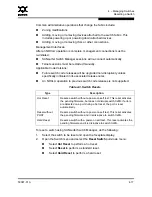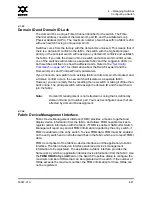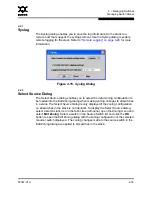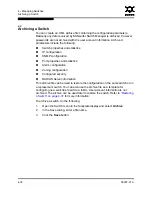
4 – Managing Switches
Configuring a Switch
4-26
59097-01 A
0
SSL
- Secure Sockets Layer. Provides secure encrypted communications
between the switch management application (GUI) and the switch. SSL
must be enabled for configuration of security and radius servers with the
switch management application (GUI). SSL certificates are generated on the
switch with the switch date/time and validated with the workstation’s
date/time. If the Switch and workstation date/time are not in sync, invalid
certificates will be generated and prevent an SSL connection from being
established between the switch and switch management application (GUI).
To disable SSL when using a user authentication RADIUS server, the
RADIUS authentication order must first be set to
Local
.
Telnet
- Command line interface. Allows users to manage the switch
through a Telnet command line interface session. Disabling Telnet access to
the switch is not recommended.
SSH
- Secure SHell. Provides secure encrypted Telnet command line
interface sessions with the switch. Note that you will have to have an SSH
client running on your workstation in order to manage your switch with Telnet
command line interface when SSH is enabled.
SNMP
- Simple Network Management Protocol. Allows management of the
switch through third-party applications that use SNMP.
NTP
- Network Time Protocol. Allows the switch to obtain its time and date
settings from an NTP server. Configuring all of your switches and your
workstations to utilize NTP will keep their date/time settings in sync and will
prevent difficulties with SSL certificates and event logs.
CIM
- Common Information Model. Allows management of the switch
through third-party applications that use CIM.
FTP
- File Transfer Protocol. Allows file transfers to the switch via FTP. FTP
is required for out-of-band firmware uploads which will complete faster than
in-band Firmware uploads.
Management Server
- Allows management of the switch through third-party
applications that use GS-3 Management Server.
4.7.5
Security Consistency Checklist Dialog
The Security Consistency Checklist dialog enables you to compare
security-related features on switches in order to check for inconsistencies. Any
changes must be made through the appropriate dialog, such as Network
Properties dialog, Switch Properties dialog, or SNMP Properties dialog. To open
the Security Consistency Checklist dialog, open the faceplate display, open the
Switch menu and select
Security Consistency Checklist
.
















































